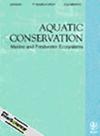Wild or Farmed: Carbon and Nitrogen Stable Isotope Values as Natural Biomarkers to Improve the Traceability of Endangered Totoaba (Totoaba macdonaldi, Sciaenidae)
Abstract
Totoaba macdonaldi is a large Sciaenid fish listed as a vulnerable species. The illegal commerce of its swimming bladder has caused severe overfishing, which has in turn been associated to the population decline of vaquita, a porpoise endemic to the Gulf of California. The present study had two objectives; the first was to use the natural carbon and nitrogen stable isotope values of wild and farmed totoaba as biomarkers to identify their origin. In the second part of the study, a group of juvenile totoabas was maintained under controlled feeding conditions to explore their rates of isotopic change and estimate the time required for the dietary isotopic values to be transferred into muscle tissue. Results from the feeding experiment indicated that muscle tissue of fish reached an isotopic equilibrium with the offered diet after 28 days for carbon and 43 days for nitrogen. Muscle samples collected from wild and farmed totoaba were analysed and data revealed that the isotopic values (carbon and nitrogen) were significantly different between both groups of organisms. A discriminant analysis using dual isotopic measurements showed a significant separation of classes, indicating that the isotopic values measured at natural abundance levels, can be effectively applied as biomarkers to support the traceability processes of farmed totoaba. The implications to promote a reduction of product mislabelling and to improve detection of illegally extracted fish are addressed.

 求助内容:
求助内容: 应助结果提醒方式:
应助结果提醒方式:


